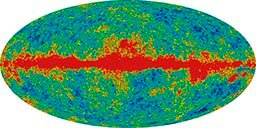NASA’s latest space-based telescope has, until now, been known as the Gamma-Ray Large Area Space Telescope (GLAST). Today, they announced the very first results, and renamed it the Fermi Space Telescope, after physicist Enrico Fermi. Fermi was one of the pioneers of modern particle physics, part of the Manhattan Project generation that created the fundamental theories and techniques that we still use today, although he died sadly young before he could see the fruition of his work in today’s standard model of particle physics. He also thought hard about a number of more speculative issues, including wondering why, if life is common in the Universe, we haven’t met any other sentient creatures yet (a question known in fact as the Fermi Paradox) — and worried that the answer might be that civilizations tend to blow themselves up.
Today’s results came in the form of an all-sky map. The band in the center is gamma-ray emission from the Milky Way galaxy, and three of the four bright spots are pulsars — fast-spinning, magnetized neutron stars, and the fourth is a kind of distant active galaxy known as a “Blazar”.

I wonder how long before someone will compare the GLAST (Fermi) maps with the microwave-band maps from WMAP like this one:

The way gamma rays are created is very different from the emission microwaves, but any soup of gas, dust, stars and magnetic fields is likely to produce both.
Just as exciting as these maps is GLAST’s ability to find Gamma-Ray Bursts, some of the most energetic objects in the Universe, whose mechanisms are still poorly understood, and which may let us peer to the epoch of the formation of the very first objects.
(All images courtesy NASA.)